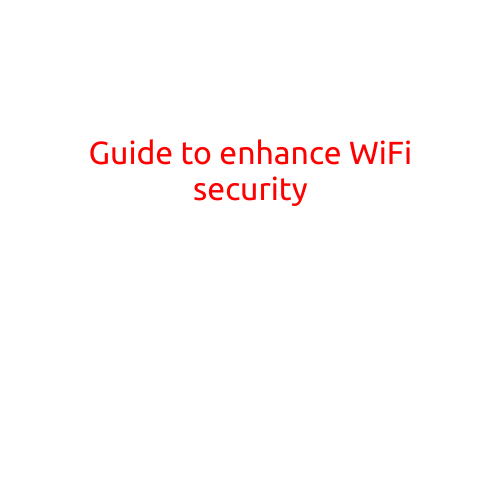
Guide to Enhance WiFi Security
As the world becomes increasingly reliant on wireless networks, WiFi security has become a growing concern for individuals and businesses alike. With the widespread use of public hotspots and the increasing risk of cyber attacks, it’s essential to take measures to enhance WiFi security. In this guide, we’ll explore the best practices to help you strengthen your WiFi security and protect your online presence.
1. Change Default Settings
The first step in enhancing WiFi security is to change the default settings of your router. Many routers ship with default settings that can be easily exploited by hackers. Change the default administrator password, network name (SSID), and network password (WEP/WPA/WPA2). Use strong, unique passwords that are difficult to crack.
2. Use WPA2 Encryption
WPA2 is the most secure WiFi encryption protocol available. It uses Advanced Encryption Standard (AES) with a 128-bit key to encrypt data. If your router doesn’t support WPA2, consider upgrading or replacing it.
3. Use a Strong Network Name (SSID)
A strong network name (SSID) can help deter hackers from attempting to access your network. Avoid using your name, address, or other identifiable information in your network name. Instead, use a unique and obscure name that doesn’t reveal any sensitive information.
4. Limit Access to Your Network
Limit access to your network by configuring your router to only allow specific devices to connect. Enable MAC address filtering to block devices with unknown or suspicious MAC addresses.
5. Regularly Update Your Router’s Firmware
Regularly update your router’s firmware to ensure you have the latest security patches and features. Check your router’s manufacturer website for firmware updates and follow their instructions to update your device.
6. Use a VPN
A Virtual Private Network (VPN) creates a secure, encrypted connection between your device and the internet. Using a VPN when connecting to public hotspots can help protect your data from being intercepted or stolen.
7. Monitor Your Network
Monitor your network for suspicious activity by using a network monitoring tool or software. These tools can help you detect and block unauthorized devices from connecting to your network.
8. Use Strong Passwords
Use strong, unique passwords for your router, devices, and online accounts. Avoid using easily guessable passwords like birthdays or common words. Use password managers to generate and store complex passwords.
9. Enable Firewall
Enable the firewall on your router and device to block incoming and outgoing traffic. This can help prevent unauthorized access to your network and devices.
10. Regularly Change Passwords
Regularly change passwords for your router, devices, and online accounts. Use a password manager to generate and store complex passwords.
11. Use Up-to-Date Antivirus Software
Use up-to-date antivirus software on all devices connected to your network to help detect and remove malicious software.
12. Use a Network Authentication Protocol
Use a network authentication protocol like 802.1X to authenticate devices before granting access to your network. This can help prevent unauthorized devices from connecting to your network.
Conclusion
Enhancing WiFi security requires a combination of technical knowledge, best practices, and regular monitoring. By following these guidelines, you can significantly reduce the risk of cyber attacks and protect your online presence. Remember to regularly update your router’s firmware, use strong passwords, and monitor your network for suspicious activity.





